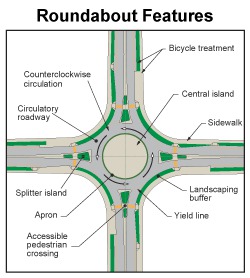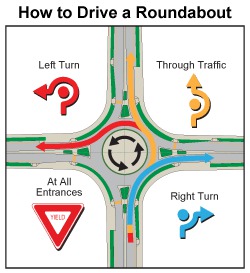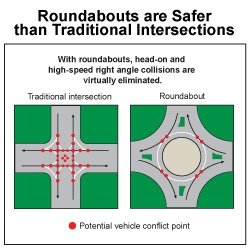
Brought to you by WBIW News and Network Indiana
Last updated on Monday, September 29, 2014
(UNDATED) - Roundabouts are becoming a relatively common traffic feature in Indiana, with more than 90 constructed through 2013 by both INDOT and cities and towns.
More than a dozen additional roundabouts are currently being planned by INDOT.
A roundabout is a circular intersection or junction in which road traffic flows almost continuously in one direction around a central island.
Modern roundabouts are different from rotaries and other traffic circles. For example, roundabouts are typically smaller than the large, high-speed rotaries still in use in some parts of the country. In addition, roundabouts are typically larger than neighborhood traffic circles used to calm traffic.
INDOT is using roundabouts to replace traditional four-way traffic signals to reduce accidents, traffic delays, fuel consumption, air pollution and construction costs, while improving safety, increasing capacity and enhancing intersection beauty.
Roundabouts have been successfully used to reduce congestion in residential neighborhoods and are accepted as one of the safest types of intersection designs.
Roundabouts are becoming a relatively common traffic feature in Indiana, with more than 90 constructed through 2013 by both INDOT and cities and towns. More than a dozen additional roundabouts are currently being planned by INDOT.
Roundabout Features

All modern roundabouts share the same features. These include:
Roundabout History
Traffic circles have been part of the transportation system in the United States since at least 1905 when one of the first circles was built in New York City. Subsequently, many large circles or rotaries were built in the United States. The prevailing designs enabled high-speed merging and weaving of vehicles.
Priority was given to entering vehicles, facilitating high-speed entries. Yet, high crash experience and congestion in the circles led to rotaries falling out of favor in America after the mid-1950s.
The modern roundabout was developed in the United Kingdom to rectify problems associated with these traffic circles. In 1966, the United Kingdom adopted a rule that required traffic entering circling intersections to give way, or yield, to circulating traffic. This rule prevented circular intersections from locking up by not allowing vehicles to enter the intersection until there were sufficient gaps in circulating traffic.
In addition, smaller circular intersections were proposed that required adequate horizontal curvature of vehicle paths to achieve slower entry and circulating speeds. These changes significantly improved the safety characteristics of the circular intersections by reducing the number and the severity of crashes.
There are an estimated 300,000 signalized intersections in the United States, according to the Federal Highway Administration. About one-third of all intersection fatalities occur at these locations, resulting in roughly 2,300 people killed each year. Furthermore, about 700 people are killed annually in red-light running collisions.
Roundabouts have demonstrated substantial safety and operational benefits compared to most other intersection forms and controls, with especially significant reductions in fatal and injury crashes.
Because the only movement allowed upon entry or exit from a roundabout is a right turn, the occurrence of crashes that result in injury is substantially reduced. Small-angle collisions, the type of collisions that can occur as a result of a right-hand turn, are typically less severe than other types of collisions.
How to Drive a Roundabout

Approach:
Enter:
Exit:
Roundabouts can easily accommodate emergency and large-sized vehicles. Drivers should behave in the same manner as they would on any other road if an emergency vehicle approaches: carefully move as far right as possible and, if necessary, stop until the emergency vehicle passes.
Benefits of a Roundabout

Lives saved:
Slower vehicle speeds:
Efficient traffic flow:
Money saved:
Community benefits:
1340 AM WBIW welcomes comments and suggestions by calling 812.277.1340 during normal business hours or by email at comments@wbiw.com
© Ad-Venture Media, Inc. All Rights Reserved.